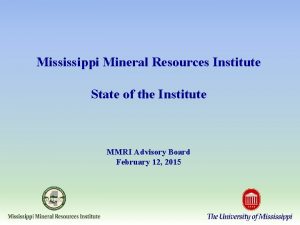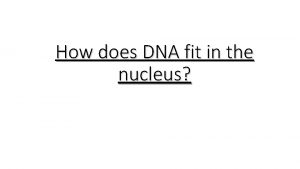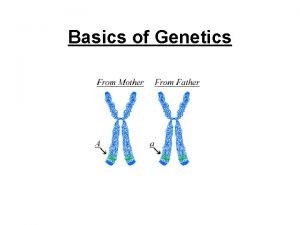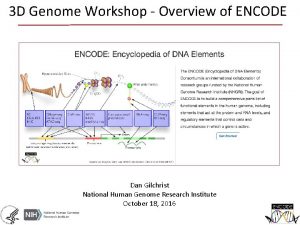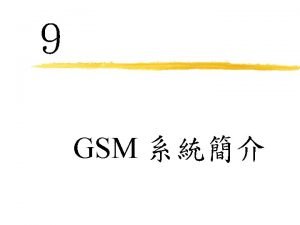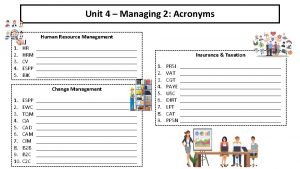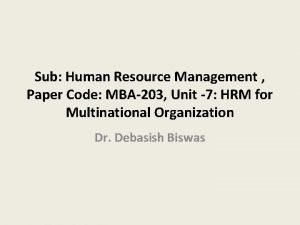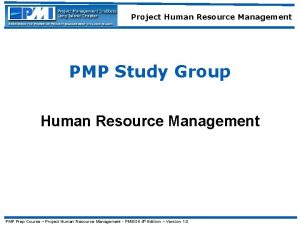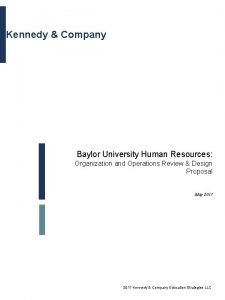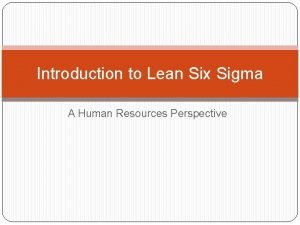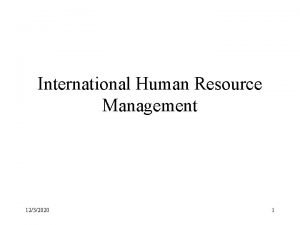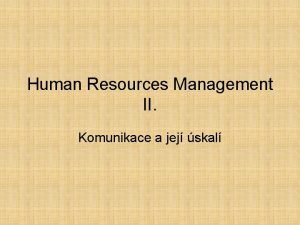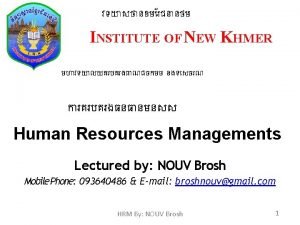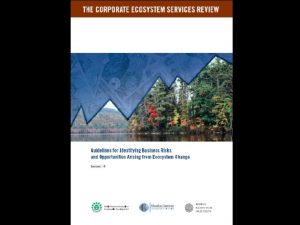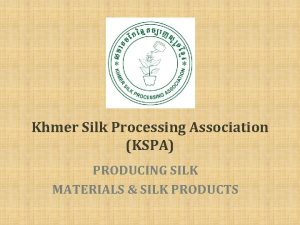INSTITUTE OF NEW KHMER Human Resources Managements Lectured






































- Slides: 38

វទយ សថ នខម រជន នថម INSTITUTE OF NEW KHMER មហ វទយ លយគរបគរងព ណជចកមម នងទ សចរណ ក រគរបគរងធនធ នមនសស Human Resources Managements Lectured by: NOUV Brosh Mobile Phone: 093640486 & E-mail: broshnouv@gmail. com HRM By: NOUV Brosh 1

PART III: Rewarding Human Resources HRM By: NOUV Brosh 2

Chapter 9: Performance Evaluation and Management HRM By: NOUV Brosh 3

What is Performance Appraisal? • a formal management system that provides for the evaluation of the quality of an individual’s performance in an organization. • appraisal is usually prepared by the employee’s immediate supervisor. • typically requires the supervisor to fill out a standardized assessment form that evaluates the individual on several different dimensions and then discuss the results of the evaluation with the employee. HRM By: NOUV Brosh 4

What is Performance Appraisal? (Con’t) What is the purpose of Performance Appraisal? • providing feedback to employees about their performance • determining who gets promoted • facilitating layoff or downsizing decisions • encouraging performance improvement • setting and measuring goals • counseling poor performers • determining compensation changes • determining individual training and development needs HRM By: NOUV Brosh 5

FOUR-PHASE MODEL OF PERFORMANCE APPRAISAL: ORGANIZATION STRATEGY Strategic Plan Mission/Vision/Values Department/Unit Objectives Common Organizational Competencies WHAT Objectives Standards Goals Results PHASE 1: PERFORMANCE PLANNING Manager’s Responsibilities • Create conditions that motivate • Eliminate performance problems • Update objectives • Provide development opportunities • Reinforce effective behavior PHASE IV: PERFORMANCE REVIEW HOW Competencies Behaviors Skills Performance Factors PHASE II: PERFORMANCE EXECUTION Individual’s Responsibilities • Achieve objectives • Solicit feedback and coaching • Communicate openly • Collect and share data • prepare for reviews JUDGING Strengths Weaknesses Compensation Potential PHASE III: PERFORMANCE ASSESSMENT HRM By: NOUV Brosh COACHING Training Development Immediate Prospects Career Planning 6

What is the difference between “results” and “behaviors”? • Results include actual job outputs, countable products, measurable outcomes and accomplishments, and objectives achieved. Results deal what the person achieved. • Behaviors include competencies, skills, expertise and proficiencies, the individual’s adherence to organizational values, and the person’s personal style, manner, and approach. Behaviors deal with how the person went about doing the job. HRM By: NOUV Brosh 7

What is the difference between “results” and “behaviors”? (Con’t) ELEMENT RESULT What the individual achieved Actual job outputs Measurable outcomes and accomplishments Objectives achieved QQCT (Quantity/Quality/Cost/Timeliness) BEHAVIOR How the individual performed Adherence to organizational values Competencies/performance factors Traits/attributes/characteristics/proficiencies Personal style, manner, and approach KASH (Knowledge/Attitudes/Skills/Habits) HRM By: NOUV Brosh 8

Example of a Performance System that includes Behavior and Results Accountabilities and Key Results Key result areas that will accomplish during the review period. Should align with company values, business goals and job description. Project Development Manage the development of project scope, cost estimate studies, and schedules for approval Performance Standards How the key result area will be measured (quality, cost, quantity). Focus on work methods and accomplishments. Interim Feedback Employee and manager discuss performanc e on an ongoing basis. Actual Results Review actual performance for key result. Performance Rating Evaluate performance on each key result. 1 = Outstanding 2 = Highly effective 3 = Acceptable Areas for Development Action Specific knowledge, and behaviors to be developed that will help employee achieve key results. What employee and manager will do to address development needs. Increase Read knowledge of project management software. articles, and meet with software vendors. 4 = Unsatisfactory Develop Preliminary By end of preliminary project material for approval within four weeks after receiving project scope. 80% of new projects receive approval. Initial cost estimates are within 5% of final estimates. project materials are developed on time year, approvals were 75% less than standard HRM By: NOUV Brosh Source: Noe, Hollenbeck, Gerhart & Wright (2003), page 355. 3 9

An Organizational Model of Performance Management Organizational Strategy Long & Short term goals and values Individual Attributes (skills, abilities) Individual Behaviors Objective Results Situational Constraints - Culture - Economic conditions HRM By: NOUV Brosh 10

Purposes of Performance Management The purposes are: • Strategic • Administrative • Developmental HRM By: NOUV Brosh 11

Performance Appraisal Developmental PURPOSE: BASIS FOR COMPARISON : APPRAISAL TECHNIQUE : ROLE OF MANAGER : Improve Performance Absolute Standard Results Oriented BARS Counselor HRM By: NOUV Brosh Administrative Information for: pay increases promotions terminations Relative Standard Rating Scale Judge 12

HOW SHOULD A COMPANY EVALUATE PERFORMANCE? Some yardsticks/criteria to consider: • fast and quick action to boss’s instructions • understand the boss’s thinking and requirements • ability to organize and schedule priorities • hardworking and willing to go the extra mile for company • meticulous attention to details and follow-up actions • ability to achieve results and performance • loyal, faithful, dedicated, committed and passionate about work • good organizational and co-ordination skills • feel for the company • assist the company to make money 2 types of royalty: 1. PERSONAL and 2. CORPORATE (expected and demanded of all paid employees. Employees are paid to perform & contribute) HRM By: NOUV Brosh 13

Performance Measures Criteria • Strategic Congruence - the extent to which the performance management system elicits job performance that is consistent with the organization’s strategy, goals, and culture. • Validity - the extent to which a performance measure assesses all the relevant aspects of job performance. • Reliability - the consistency of a performance measure; the degree to which a performance measure is free from random error. • Acceptability - the extent to which a performance measure is deemed to be satisfactory or adequate by those who use it. • Specificity - the extent to which a performance measure gives detailed guidance to employees about what is expected of them and how they can meet those expectations. HRM By: NOUV Brosh 14

Factors that Influence Performance Motivation • • • Career ambition Employee conflict Frustration Fairness/satisfaction Goals/expectations • • Equipment/materials • • Job design • • Economic conditions • • Unions • Rules and policies • Management support • Laws and regulations Environment P = f (A, M, E) Ability Technical skills Interpersonal skills Problem-solving Analytical skills Communication skills Physical limitations HRM By: NOUV Brosh 15

Establishing Performance Standards Strategic relevance-performance standards linked to organizational goals and competencies. Strategies and Competencies Criterion contamination-elements that affect the appraisal measures that are not part of actual performance. Performance. Measure Performance Measures Zone of Valid Assessment Criterion deficiency--aspects of actual performance that are not measured. Actual Performance HRM By: NOUV Brosh Reliability--consistent measurement across raters and/or over time. 16

HOW TO ESTABLISH AN EFFECTIVE APPRAISAL PROGRAM? ESTABLISHING PERFORMANCE STANDARDS : • strategic relevance - performance standards that linked to organizational goals and competencies. For example, setting an objective that 95% of all customer complaints must be resolved within one day, then such standard would be use to evaluate sales service representatives. • criterion deficiency - aspects of actual performance that are not being measured. For example, when performance standards focus on a single criterion (e. g. , sales revenue), to the exclusion of other but less quantifiable performance dimensions (e. g. , customer service), then the appraisal system is said to suffer from criterion deficiency. HRM By: NOUV Brosh 17

HOW TO ESTABLISH AN EFFECTIVE APPRAISAL PROGRAM? (Con’t) • criterion contamination - elements that affect the appraisal measures that are not part of the performance. Just as performance criteria can be deficient, they can also be contaminated. There are factors outside an employee’s control that can influence his/her performance. For example, a comparison of Mild-Seven cigarette salesman should not be contaminated by the fact that locations (provinces) differ in sales potential. • reliability - consistent measurement across raters and/or over time. In ratings, reliability must be measured by correlating two sets of of ratings made by a single rater or by two different raters. For example, two managers may rate the same individual and estimate his/her suitability for a promotion. Their ratings could be compared to determine inter-rater reliability. HRM By: NOUV Brosh 18

Pitfalls in Performance Appraisals Common Appraisal Errors Error of Central Tendency Performance-rating error in which all employees’ re rated above average. Leniency or Strictness Error - performancerating error in which the appraiser tends to give employees either unusually high or unusually low ratings Similar-to-Me Error performance-rating error in which an appraiser inflates the evaluation of an employee because of a personal mutual connection HRM By: NOUV Brosh Recency Error performance-rating error in which the appraisal is based largely on the employee’s most recent behavior rather than on behavior throughout the appraisal period Contrast Error performance- rating error in which an employee’s evaluation is based either upward or downward because of comparison with another employee just previously evaluated 19

Performance Measurement Approaches • • • Comparative – ranking – forced distribution – paired comparison Attribute – graphic rating scales – mixed standard scales Behavioral – critical incidents – Behaviorally Anchored Rating Scales (BARS) – Behavioral Observation Scales (BOS) – Organizational Behavior Modification (OBM) – assessment centers Results – MBO – Productivity Measurement & Evaluation System (Pro. MES) The Quality Approach HRM By: NOUV Brosh 20

Performance Appraisal: Trait Methods Graphic Rating Scale - a trait approach to p. a whereby each employee is rated according to a scale of characteristics Mixed Standard Scale - a trait approach to p. a similar to other scale methods but based on comparison with (better than, equal to, or worse than) a standard Forced-Choice - a trait approach to p. a that requires the raters to choose from statements designed to distinguish between successful & unsuccessful performance Essay - a trait approach to p. a that requires the rater to compose a statement describing employee behavior Common Trait Methods of Appraisal HRM By: NOUV Brosh 21

Performance Appraisal: Behavioral Methods Critical Incidents - unusual event that denotes superior of inferior employee performance in some part of the job Behavioral Checklist - consists of having the rater check those statements on a list that the rater believes are characteristic of the employee’s performance or behavior Behavior Observation Scales (BOS) - a behavioral approach to performance appraisal that measures the frequency of observed behavior Behaviorally Anchored Rating Scale (BARS) - a behavioral approach to performance appraisal that consists of a series of vertical scales, one for each important dimension of job performance Common Behavioral Appraisal Methods HRM By: NOUV Brosh 22

EXAMPLES OF PERFORMANCE METHODS A. GRAPHIC RATING SCALES (A TRAIT APPROACH TO PA) Appraise employee's performance in PRESENT ASSIGNMENT. Tick ( ) t h e most appropriate square. Appraisers are urged t o freely use the "Remarks" sections for significant descriptive of the individual. 1. KNOWLEDGE Needs instruction or guidance OF WORK : n Understanding of all phases of his/her work Has required knowledge of own and related work Has exceptional knowledge of own and related work n n Remarks: and related matters 2. INITIATIVE : Lacks imagination Ability t o originate n or develop ideas and application t o his/her work Meets necessary requirements Unusually resourceful q q Remarks: 3. APPLICATION : Attention and application t o Wastes time (needs close supervision) n his/her work 4. QUALITY OF WORK : Needs improvement Thoroughness, andaccuracy of work 5. VOLUME OF WORK : n Regularly meets recognized standards n Exceptionally industrious Consistently maintains high quality CJ-+----Cl-+----r=l-+----------r=l----- Remarks: Should be increased n Quantity of acceptable work n Steady and willing worker Remarks: Regularly meets recognized standards n n HRM By: NOUV Brosh Unusually high output n n 23

B. MIXED-STANDARD SCALE (A TRAIT APPROACH TO PA) • B. MIXED-STANDARD SCALE (A TRAIT APPROACH TO PA) • INSTRUCTIONS: Please indicate whether the individual’s performance is above (+), equal to (0), or lower (-) than each of the following standards. • 1. Employee uses good judgement when addressing problems and provides workable alternatives; however, at times does not take actions to prevent problems. (MEDIUM PROBLEM SOLVING) 2. Employee lacks supervisory skills; frequently handles employees poorly and is at times argumentative. (LOW LEADERSHIP) 3. Employee is extremely cooperative; can be expected to take the lead in developing cooperation among employees; completes job tasks with a positive attitude. (HIGH COOPERATION) 4. Employee has effective supervision skills; encourages productivity, quality, and employee development. (MEDIUM LEADERSHIP) 5. Employee normally displays an argumentative or defensive attitude toward fellow employees and job assignments. (LOW COOPERATION) 6. Employee is generally agreeable but becomes argumentative at times when given job assignments; cooperates with other employees as expected. (MEDIUM COOPERATION) 7. Employee is not good at solving problems; uses poor judgement and does not anticipate potential difficulties. (LOW PROBLEM SOLVING) 8. Employee anticipates potential problems and provides creative, proactive alternative solutions; has good attention to follow-up. (HIGH PROBLEM SOLVING) 9. Employee displays skilled direction; effectively coordinate unit activities; is generally a dynamic leader and motivates employees to high performance. (HIGH LEADERSHIP) • • HRM By: NOUV Brosh 24

C. BEHAVIOURALLY ANCHORED RATING SCALES (BARS) (A BEHAVIORAL APPROACH TO PA) Instructions: Select the rating that best describes the behavior of the employee you are appraising for each dimension: JOB : FRONT DESK RECEPTIONIST DIMESNSION : CUSTOMER FOCUS RATING The names of regular customers are recalled from memory. The customer is greeted warmly and acknowledged on completion of business. 1 2 Is attentive to the customer if he or she is required to wait. 3 Displays irritation with the customer if asked questions. 4 Fails to deal with customer queries adequately. 5 Leaves customer waiting while chats to other staff. 6 1 - EXCELLENT 4 - POOR PERFORMANCE 2 - GOOD PERFORMANCE 5 - VERY POOR PERFORMANCE 3 - AVERAGE PERFORMANCE 6 - EXTREMELY POORBy: PERFORMANCE HRM NOUV Brosh 25

D. BEHAVIOR OBSERVATION SCALES (BOS) (A BEHAVIORAL APPROACH TO PA) INSTRUCTIONS: Please consider the Sales Representative’s behavior on the job in the past rating period. Read each statement carefully, then circle the number that indicates the extent to which the employee has demonstrated this effective or ineffective behavior. For each behavior observed, use the following scale: 5 represents almost always 95 - 100% of the time 4 represents frequently 85 - 94% of the time 3 represents sometimes 75 - 84% of the time 2 represents seldom 65 - 74% of the time 1 represents almost never 0 - 64% of the time SALES PRODUCTIVITY ALMOST NEVER ALMOST ALWAYS 1. Reviews individual productivity results with manager 1 2 3 4 5 2. Suggests to peers, ways of building sales 1 2 3 4 5 3. Formulates specific objectives for each contact 1 2 3 4 5 4. Focuses on product rather than customer problem 1 2 3 4 5 5. Keeps account plans updated 1 2 3 4 5 6. Keeps customer waiting for service 1 2 3 4 5 7. Anticipates and prepares for customer concerns 1 2 3 4 5 8. Follows up on customer leads 1 HRM By: NOUV Brosh 2 3 4 5 26

Summary of Appraisal Methods TRAITS ADVANTAGES Inexpensive Meaningful Easy to use BEHAVIOR Specific dimensions Accepted by employees Useful for feedback OK for reward/promotion RESULTS Less subjectivity bias Accepted by employees Performance-reward link Encourages goal setting Good for promotion decisions DISADVANTAGES Potential for error Poor for counseling Poor for allocating rewards Poor for promotional decisions Time consuming Costly Some rating error Time consuming Focus on short term Criterion contamination Criterion deficiency HRM By: NOUV Brosh 27

DECIDING WHO SHOULD DO THE APPRAISAL : • MANAGER/SUPERVISOR APPRAISAL • SELF-APPRAISAL • SUBORDINATE APPRAISAL • PEER APPRAISAL • TEAM APPRAISAL • 360 DEGREE APPRAISAL HRM By: NOUV Brosh 28

Alternative Sources of Appraisal SUPERIOR CUSTOMERS PEERS TEA M SELF SUBORDINATES HRM By: NOUV Brosh 29

DECIDING WHO SHOULD DO THE APPRAISAL : • MANAGER/SUPERVISOR APPRAISAL • SELF-APPRAISAL • SUBORDINATE APPRAISAL • PEER APPRAISAL • TEAM APPRAISAL • 360 DEGREE APPRAISAL HRM By: NOUV Brosh 30

What is 360 -degree appraisal? • What is 360 -degree appraisal? - a performance appraisal process for managers and supervisors that includes evaluations from a wide range of persons who interact with the manager/supervisor. The process includes self-evaluations as well as evaluations from the manager/supervisor’s boss, subordinates, peers, and customers. • The 360 -degree appraisal is intended to provide employees with as accurate a view of their performance as possible by getting input from all angles: immediate superiors, peers, subordinates, customers and anybody’s else who has direct interaction with the employee in his/her work. • It is useful as a feedback for both developmental and administrative purposes. HRM By: NOUV Brosh 31

ADVANTAGES AND DISADVANTAGES OF 360 -DEGREE APPRAISAL: ADVANTAGES DISADVANTAGES The system is more comprehensive in that responses are gathered from multiple perspectives Quality of information is better. It compliments TQM initiatives by emphasizing internal/external customers. It may lessen bias/prejudice since feedback comes are from more people, not one individual. Feedback from peers and others may increase employee self-development. • The system is complex in combining all the responses. • Feedback can cause intimidating and resentment if employees feel the respondents have “ganged up”. • There may be conflicting opinions, though they may all be accurate from the respective standpoints. • The system requires training to work effectively. • Employees may collude or “game” the system by giving invalid evaluations to one another. • Appraisers may not be accountable if their evaluations are anonymous HRM By: NOUV Brosh 32

How to establish an effective 360 -degree appraisal system? • • • Assure anonymity. Make respondents accountable. Prevent “gaming” of the system. Use statistical procedures. Identify and quantify biases. HRM By: NOUV Brosh 33

Performance Appraisal under an MBO Program Step 5 a: Inappropriate goals/metrics deleted Step 1: Organization goals and metrics Step 2: Department goals and metrics Step 7: Review of organization performance Step 3: Supervisor lists goals and metrics for subordinate Step 3: Subordinate proposes goals and metrics Step 6: Final review Step 5 b: New inputs are then provided Step 4: Mutual agreement of goals and metrics HRM By: NOUV Brosh Step 5: Interim review 34

Appraisal Interviews Ask for Self. Assessment Follow Up Day by Day Invite Participation Establish Goals Express Appreciation Be Supportive Minimize Criticism Focus on Problem Solving Change the Behavior, not the Person HRM By: NOUV Brosh 35

Why Performance Appraisals May Fail? HRM By: NOUV Brosh 36

Improving Performance Feedback • • • Give feedback frequently Create the right context for the discussion Have employee do self-evaluation before session Encourage participation during session Praise effective performance Focus on solving problems Focus feedback on behavior or results Minimize criticism Set specific goals and a date to review progress HRM By: NOUV Brosh 37

Reading Cases Case 9 -1: Evaluating store managers at Bridgestone/Firestone Tire and Rubber on page 287 to 290. Case 9 -2: The Politics of Performance Appraisal on page 290 to 292 HRM By: NOUV Brosh 38
 Yom kippur war apush
Yom kippur war apush Six khmer
Six khmer Khmer rouge timeline
Khmer rouge timeline Cambodian genocide scarf
Cambodian genocide scarf Khmer sex
Khmer sex Southeast asia climate
Southeast asia climate Empire khmer
Empire khmer Khmer empire
Khmer empire Mississippi mineral
Mississippi mineral Oregon forest resources institute
Oregon forest resources institute Operation transformation process
Operation transformation process Variable resources definition
Variable resources definition Renewable vs nonrenewable resources worksheet
Renewable vs nonrenewable resources worksheet National human genome research institute
National human genome research institute National human genome research institute
National human genome research institute National human genome research institute
National human genome research institute National human genome research institute
National human genome research institute Duke human vaccine institute
Duke human vaccine institute Nj institute for continuing legal education
Nj institute for continuing legal education Etsi
Etsi Wmata human resources
Wmata human resources Human resources acronyms
Human resources acronyms My ufl
My ufl Difference between domestic and international hrm
Difference between domestic and international hrm Resource histogram
Resource histogram What are physical resources
What are physical resources Human resources and job design
Human resources and job design Mba meaning college
Mba meaning college Recruitment process of max's restaurant
Recruitment process of max's restaurant Managing human resources in small and entrepreneurial firms
Managing human resources in small and entrepreneurial firms Empower human resources
Empower human resources Baylor university hr
Baylor university hr Six sigma in hr
Six sigma in hr Human resource management definition
Human resource management definition Human resources videregående uddannelser
Human resources videregående uddannelser Short term and long term human resource planning
Short term and long term human resource planning Historie human resources
Historie human resources Chapter 9 human resource management
Chapter 9 human resource management Human resources claudia
Human resources claudia








